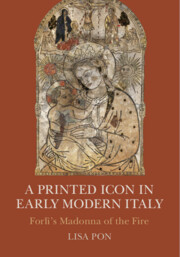Book contents
- Frontmatter
- Contents
- List of Illlustrations
- Acknowledgments
- A Printed Icon in Early Modern Italy
- Part I Thing
- Part II Emplacement
- Part III Mobilities
- Six Moving in the City: The Translation of 1636
- Seven Mobile in Print: The Procession on Paper
- Eight Multiplied: The Madonna of the Fire in Forlì and Beyond
- Notes
- Selected Bibliography
- Index
Six - Moving in the City: The Translation of 1636
from Part III - Mobilities
Published online by Cambridge University Press: 05 April 2015
- Frontmatter
- Contents
- List of Illlustrations
- Acknowledgments
- A Printed Icon in Early Modern Italy
- Part I Thing
- Part II Emplacement
- Part III Mobilities
- Six Moving in the City: The Translation of 1636
- Seven Mobile in Print: The Procession on Paper
- Eight Multiplied: The Madonna of the Fire in Forlì and Beyond
- Notes
- Selected Bibliography
- Index
Summary
A memory is mobilized and commemorated within a spiritual framework and the domain marked by this ritual practice is a symbolic space.
Martine BoiteuxEnshrinement, the removal of the Madonna of the Fire from the quotidian practices of Lombardino da Ripetrosa's classroom and its emplacement into the ecclesiastical enclosures of tabernacle, chapel, and cathedral, both confirmed and focused its numinous power into a single site. In contrast to Rome's Salus Populi Romani, whose translation into the Pauline Chapel in Santa Maria Maggiore in 1613 marked a much less mobile phase for that Marian icon, the Madonna of the Fire did not always remain physically contained within its new chapel. Balancing the concentrated and usually veiled stasis in that privileged locus in the cathedral, Forlì's icon was repeatedly taken out into the city, to be moved and displayed along processional routes throughout the urban fabric. The passing presence of the Madonna of the Fire, transient but recurrent, thus activated a mobile sacred geography in the cityscape at large. Furthermore, while the Madonna of the Fire in its chapel acted as a magnetic focus for the devotions of the Forlivese who prayed to her regularly, the moving icon, when carried through the streets, brought pious engagement with the Madonna of the Fire outdoors into the city's open spaces and organized the populace into participants and spectators of socio-spatial rituals that circled the civic center repeatedly.
In the seventeenth and eighteenth centuries, these types of rituals moved the Madonna of the Fire around the city again and again, first and foremost on the anniversaries of the originary miracle of the fire on February 4 and of the translation of the print into its chapel on October 20. Besides these regular annual events, various extraordinary occasions prompted rituals displaying the Madonna of the Fire within the urban fabric of Forlì.
- Type
- Chapter
- Information
- A Printed Icon in Early Modern ItalyForlì's Madonna of the Fire, pp. 141 - 167Publisher: Cambridge University PressPrint publication year: 2015

